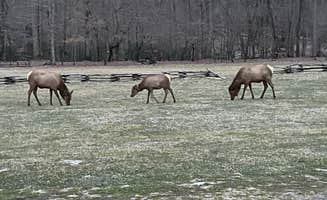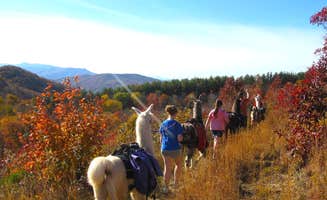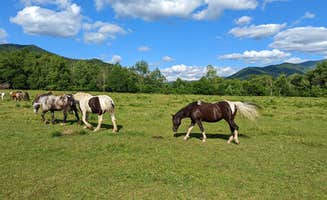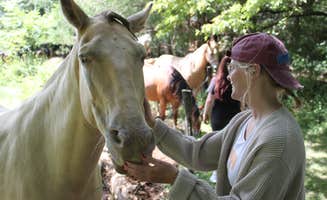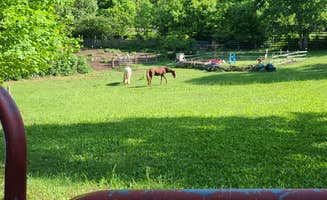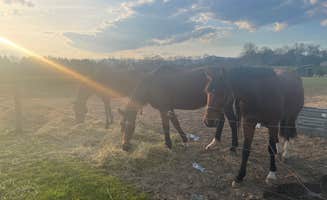Equestrian camping near Hartford, Tennessee focuses on several key areas in the Pisgah National Forest and Great Smoky Mountains National Park. The region sits along the North Carolina-Tennessee border at elevations ranging from 1,700 to over 3,000 feet, creating a cooler microclimate especially beneficial during summer months. Trail systems throughout the area connect to various mountain peaks and waterways, with camping options typically open from March through October.
What to do
Elk viewing opportunities: Cataloochee Valley, accessible from camping areas, offers prime wildlife viewing. "The wild life here is so wonderful. If you want to see the elk, you're going to have to be up early. I use to be in the park at 5 AM with night vision gear, I saw some very nice elk," notes Patrick K. from Cataloochee Campground.
Water activities: Several streams and swimming holes provide relief from summer heat. "The falls were beautiful, and jumping into Midnight Hole was fun. Even at midnight :)," reports Chris M. from Big Creek Campground.
Historical exploration: Pioneer structures throughout the area offer glimpses into mountain settlement history. "There are several historic structures in the area--a school, a church, barns, old houses, etc," explains Myron C., highlighting the cultural aspects beyond horseback riding.
What campers like
Creek-side camping: Many sites feature water proximity as a major draw. "A nice feature is how close the campsites are to the creek. It was great for the dogs to cool off. There are also swimming holes nearby," says Katrin M. about the tent camping options.
Forest seclusion: Sites at Harmon Den Area offer privacy among mature trees. "There are a few dispersed camping sites at Harmon's Den, and they are spacious sanctuaries beside Cold Springs Creek," describes Myron C., noting the peaceful setting.
Higher elevations: Summer temperatures remain cooler at mountain camps. "The camp is at 3144 feet in elevation according to my altimiter app so it is nice and cool," reports Overland 1., appreciating the natural climate control that elevation provides during warmer months.
What you should know
Road conditions: Access roads to several areas require careful driving. "The road is quite the trip just in a car, and I can't imagine driving a large RV on it," cautions Kristina about approaching Cataloochee Campground.
Crowding at attractions: Popular spots can become congested quickly. "When we made it there, the parking lot was full, and there were cars lined up for about a half mile down the road," warns Myron C. regarding Max Patch, a scenic mountain bald crossed by the Appalachian Trail.
Limited facilities: Most equestrian camping areas have minimal amenities. "There was supposed to be access to water, but the only pump in the campground was not working," explains a visitor to Harmon Den Horse Campground, highlighting the need to bring your own supplies.
Tips for camping with families
Swimming options: Natural water features provide entertainment for children. "There's an area of the stream where little kids can easily play which is important because I have a three-year-old," notes Kristina about Cataloochee.
Wildlife viewing scheduling: Planning specific times increases chances of animal sightings. "Early in the morning or late in the afternoon, you can drive about a mile, and sometimes less, to see elk and lots of them," advises Myron C. from Cades Cove Campground.
Tent pad sizes: Sites accommodate various tent configurations. "Tent pads are large and size allowing for even the largest of tents," mentions Crystal C., which proves helpful for families requiring larger sleeping spaces.
Tips from RVers
Gate access requirements: Some campgrounds restrict entry using coded gates. "The gate to this camp is locked but they email you the combination with your booking confirmation. The lock is a little hard to open," explains Overland 1. about Harmon Den Horse Campground.
Limited hookups: Prepare for primitive camping conditions. "No electricity, so if you need to charge your battery, you'll need to have a generator," advises Patrick K., emphasizing the need for self-sufficiency.
Parking constraints: Some sites separate vehicles from camping areas. "You cannot park your car right on the campsite. There is a parking lot and you need to carry your gear in. It's about 100 feet to the sites," notes Katrin M. about the logistics of setting up camp.



